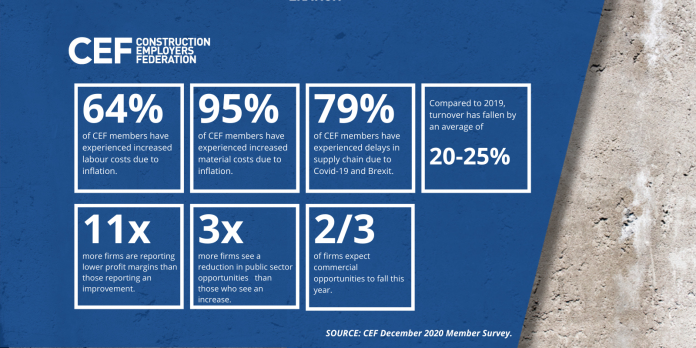Key findings from the Construction Employers Federation State of Trade Survey has shown a resilient sector in the second half of 2020 – but one with significant concerns about short to medium term workloads, profit margins and delays to supply chains.
The survey, which was conducted in late December/early January and covers the last six months of 2020, contained the responses of 80 Northern Ireland-headquartered construction firms with a combined turnover of £1.5bn per annum and reflected an industry that got back on its feet with the lifting of restrictions on its activity due to the pandemic but which, at the start of 2021, looks into what may be the most uncertain future it has seen since the 2008 recession.
The key findings include:
- A game of two halves with two-thirds of turnover completed in H2 – that is twice the activity in H2 than H1 and was due to the lifting of restrictions on construction work.
- On average turnover was still down 20-25% on 2019.
- The number of firms reporting a deterioration in profit margins outnumbered those reporting an improvement by more than eleven to one.
- Over half of firms are operating at full or almost full capacity (53% ) while the remainder (47%) are operating at ¾ capacity or less.
- Encouragingly the vast majority – 82% – of firms expect furloughed staff to be retained.
- Cost inflation has led to rapid input costs rises with 64% of responders seeing increases in labour costs, 95% in material costs and 67% in plant costs.
- 79% have experienced delays in supply chains as a result of Covid-19 and Brexit.
- 35% have seen the delays in supply chains severely disrupt their business while 35% haven’t but expect it to in due course.
- Prospects for the year ahead – Almost 3 x as many firms (43%) see reduced opportunities in the public sector than those who expect increased opportunities. Even more stark for NI commercial opportunities with two-thirds expecting these to fall in the next year while 4% foresee increases. On commercial opportunities in GB market, 17% see these reducing with 17% expecting increases.
Mark Spence, Managing Director of the Construction Employers Federation said of the survey:
“The CEF is immensely proud of its members, their employees and supply chains who did so much throughout 2020 to put in place the infrastructure that enabled our health and wider public services across these islands to meet the challenges of the pandemic head on.
“Our State of Trade Survey very clearly shows that, with the easing of restrictions on construction activity in the second half of 2020, many firms were able to recover a large part of the turnover lost in the first half of 2020 and, crucially, do it in a Covid-secure manner.
“However what is equally apparent from the survey is that many contractors believe we are facing into a perfect storm.
“With a challenging commercial market into this year, and likely next, there will undoubtedly be more competition for public works. While this, in many ways, should be seen as a good thing – it must be acknowledged that this is occurring at a time when a significant number of public sector works are being procured as ‘price only’. The absence of ‘quality’ with respect to tender scoring has the capacity to drive the market down to unsustainably low pricing.
“The challenges are exacerbated by the early year impacts on materials supply and pricing. While well publicised issues on matters like steel imports will, likely, begin to resolve themselves on the supply side – where the price will settle is, at this stage, harder to gauge. That, alone, puts massive pressure on contractors now to price appropriately for both one off projects and, more alarmingly, longer term arrangements such as measured term contracts.
“The draft Northern Ireland Executive Budget for 2021/22 that is currently out for consultation shows a growth in annual capital expenditure that is to be welcomed. To build confidence within the industry it is important that its detailed planning its speedily undertaken and published by Departments – and that Government Clients fully understand the multitude of pressures that contractors are currently facing. As we move into the new financial year, it will then be crucial that the Executive works with the industry to develop and embed a recovery strategy that seeks to incentivise the commercial sector to recommence investment.
“We know from the experience of the 2008 recession that the construction industry always feels a lag in terms of the worst effects of an economic downturn. The warning signs are already there. It is incumbent on those that value the sector to ensure it doesn’t come to pass.”
Commenting on the latest survey findings, Richard Ramsey, Chief Economist Northern Ireland, Ulster Bank, said:
“The local construction industry rebounded in the second half of last year and recovered much of the turnover lost due to lockdown restrictions. The speed and scale of the construction sector’s recovery has been much swifter than after the last recession more than a decade ago. Fortunately, this time around, austerity and swingeing cuts to the government’s capital investment plans are not on the menu. Nor is there a legacy of negative equity to sap demand for residential housing for years to come. Nevertheless, there is a sense of déjà vu at some of the challenges facing construction firms in 2021 and beyond.
“Three key challenges evident in the latest Construction Employers’ Federation State of Trade Survey concern demand, supply-side disruption and inflationary pressures. In turn, the interaction of these factors will put pressure on profitability. Indeed, the spectre of negative profit margins may become more widespread this year like it was a decade ago.
“According to the industry, two key demand challenges stand out. These are the significant reduction in public sector opportunities in 2021; with almost three times as many firms (43%) anticipating reduced opportunities relative to those expecting an increase. Even more stark is the anticipated drop in demand within Northern Ireland’s commercial market. The legacy of COVID-19, both in terms of debt and working from home, will shape demand within this sector for the foreseeable future. Perhaps not surprisingly two-thirds of local firms expect commercial market opportunities to fall in 2021.
“Eight out of ten construction firms have experienced delays in their supply-chains as a result of either COVID-19 or Brexit. For over one-third of firms (35%) the delays experienced so far have already severely disrupted their business. A further 35% expect severe disruption to occur in due course. Supply-chain disruption has been par for the course during January and it is not just down to Brexit and COVID-19. The global shipping industry is struggling to deliver what the world wants to buy during lockdown. A shortage of containers is choking exports and has triggered a surge in prices. Some ports are reporting tenfold increases in the cost of containers. This has been impacting on manufacturers, consumers and the construction industry.
“Disruption in the global logistics industry adds yet another layer of uncertainty – in terms of cost and delivery times – on top of Brexit and COVID-19 related disruptions. Resilience and patience are two qualities exemplified by the construction industry. And these virtues will be tested in the coming months. Indeed, local construction firms face a perfect storm of uncertainty as far as public procurement and tendering are concerned. Supply-chain disruptions alongside significant price rises for construction related materials make it difficult, if not impossible, for firms to accurately price tenders on a profitable basis. Given that Northern Ireland’s public procurement tenders are awarded on ‘price only’ evaluations this presents risks to both firms’ profitability and the quality of the projects undertaken. A lack of sufficient workloads could lead to a race to the bottom on price. While this may appear desirable from a value for money perspective, it is not sustainable – nor in the interests of the local economy – to have an unprofitable construction sector.”








